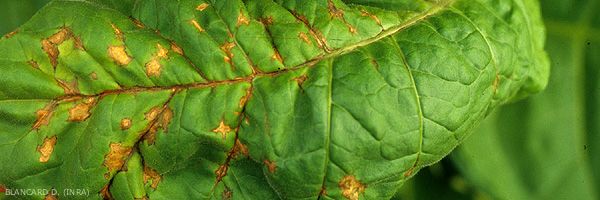
Tomato spotted wilt virus
(TSWV)
- classification : Bunyaviridae, Tospovirus
Tomato spotted wilt virus (TSWV) is shown in figure 1. Recent studies from a large number of isolates showed that they could be separated into two serologically distinct groups:
-The L-TSWV (for lettuce) seems to be the most common;
-The I-TSWV (for impatiens); isolates of this group are now considered to belong to another virus, named "Impatiens necrotic spot virus" (INSV).
 |
| Figure 1 |
This virus is extremely polyphagous and distributed worldwide. It occurs with different severity in many tobacco-producing countries. Its damage is very important in several US states, in various Eastern European countries (Bulgaria, Hungary, Poland ...) and Greece. It seems on the rise in some countries in Asia and Oceania.
In France this virus used to infect many crops and sometimes tobacco, but it almost disappeared before the second world war. During the 80s, the introduction of a new vector, the thrips Frankliniella occidentalis, changed the situation. It is now considered a concern for many horticultural crops grown under shelter. In some tobacco production areas, the coexistence of contaminated floral and vegetable crops should be taken seriously because the risk of contamination exists. Contrary to what is observed in the Eastern European countries, thrips do not proliferate in tobacco fields; maybe for this reason TSWV is not spreading currently in tobacco crops.
U.S. situation
TSWV was first reported in Georgia tobacco in 1986, but was not considered a problem in the crop until 1989 the same year that TSWVwas reported for the first time in North Carolina tobacco. The most devasting epidemic on tobacco crops in the southeast U.S. occurred in 2002. Because the virus can infect more than four hundred species of plants, including many native and introduced plants found in the southeast U.S., it is entrenched there in the agricultural landscapes and is unlikely to disappear. Planning for TSWV management is crucial for growers in areas where the virus is firmly established; growers in other areas must remain vigilant against this disease.
(Mina Mila - North Carolina State University)





